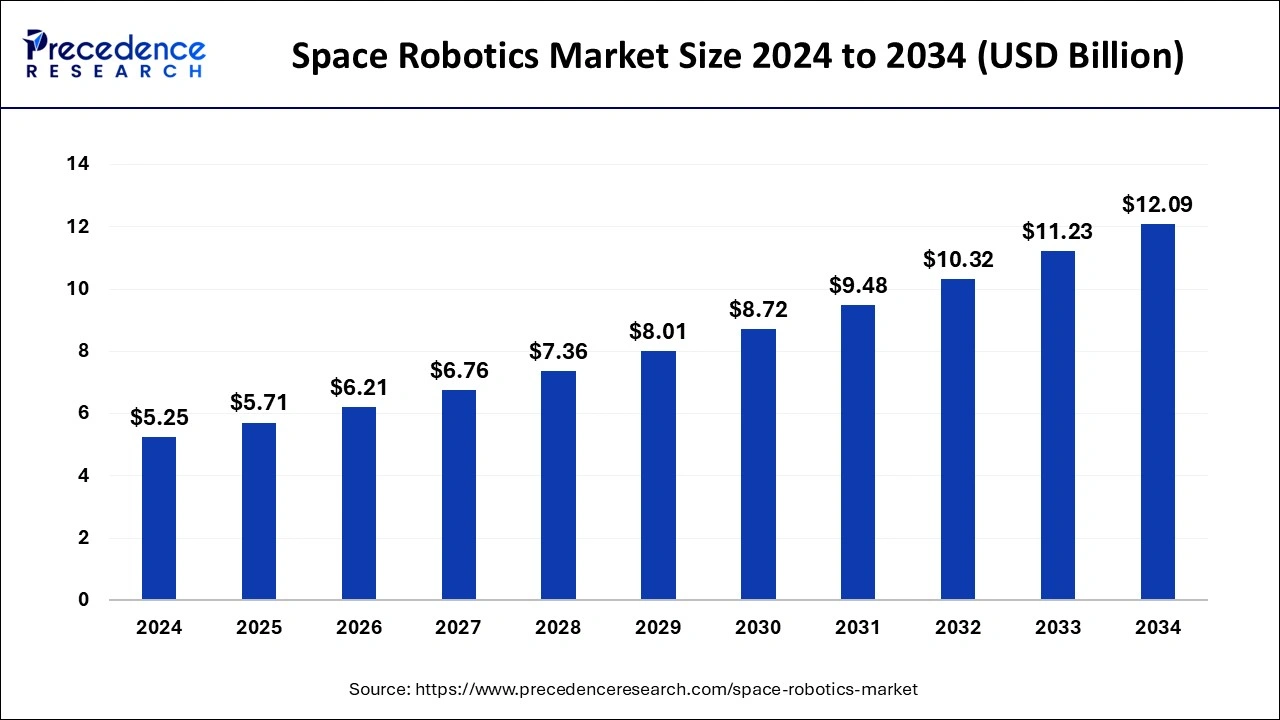The global space robotics market size reached USD 4.82 billion in 2023 and is anticipated to hit around USD 11.23 billion by 2033, growing at a CAGR of 8.83% from 2024 to 2033.
Key Takeaways
- North America dominated the market with the largest market share of 56% in 2023.
- By solution, the remotely operated vehicles segment has held the largest market share of 38% in 2023.
- By application, the near space segment has contributed the largest market share of 41% in 2023.
- By organization, the government segment has generated more than 71% of market share in 2023.

The space robotics market has witnessed substantial growth in recent years, driven by advancements in technology and increasing space exploration missions. Space robotics refers to the development and deployment of robotic systems for various tasks in space exploration, including satellite servicing, planetary exploration, space station maintenance, and asteroid mining. The market has experienced significant growth due to several key factors, including technological advancements, government initiatives, and the increasing commercialization of space activities.
Get a Sample: https://www.precedenceresearch.com/sample/4009
One of the primary growth factors for the space robotics market is the rapid advancement of robotics and artificial intelligence (AI) technologies. These advancements have led to the development of highly sophisticated robotic systems capable of performing complex tasks in extreme environments, such as outer space. Furthermore, the miniaturization of components and the development of advanced sensors have enabled the creation of smaller, more agile robots suitable for space exploration missions.
Regionally, North America has emerged as a dominant player in the space robotics market, primarily due to the presence of leading space agencies such as NASA and significant investments in space exploration programs. The United States, in particular, has been at the forefront of space robotics development, with a robust ecosystem of government agencies, aerospace companies, and research institutions driving innovation in the field. Additionally, collaborations between government agencies and private companies have further accelerated the growth of the space robotics market in the region.
The increasing demand for satellite servicing and maintenance missions is another significant driver fueling the growth of the space robotics market. With the growing number of satellites in orbit, there is a need for robotic systems capable of extending the lifespan of satellites, repairing malfunctioning components, and removing space debris. Moreover, the emergence of new space initiatives, such as satellite constellations for broadband internet and Earth observation, is expected to drive further demand for satellite servicing capabilities.
Opportunities abound in the space robotics market, particularly in the exploration and utilization of resources on celestial bodies such as the Moon and Mars. Robotic systems equipped with advanced sensing and manipulation capabilities can be deployed for prospecting and mining valuable resources, including water ice and rare minerals. Additionally, the development of autonomous rovers and drones for planetary exploration offers opportunities for companies to contribute to future space missions and scientific discoveries.
However, the space robotics market also faces several challenges that could hinder its growth potential. One of the primary challenges is the high cost associated with the development and deployment of space robotic systems. Building robots capable of withstanding the harsh conditions of space and operating reliably over long durations requires significant investments in research, development, and testing. Moreover, the complexity of space missions and the inherent risks involved pose challenges for companies seeking to enter the space robotics market.
Recent Developments
- In February 2024, an Autonomous Robotic Arm System aimed to advance space station robotics.
- In January 2024, ABB expanded its leadership in next-generation AI-enabled mobile robotics through the acquisition of Sevensense.
- In June 2023, Intrinsic and Siemens collaborated to accelerate the integration of AI-based robotics and automation technology.
- In July 2022, NanoRacks and GITAI partnered for the second in-space demonstration of a robotic system on the ISS.
Space Robotics Market Companies
- ALTIUS SPACE MACHINES.
- ASTROBOTIC TECHNOLOGY
- BluHaptics, Inc.
- Honeybee Robotics
- Intuitive Machines, LLC.
- MAXAR TECHNOLOGIES
- Metecs, LLC.
- Motiv Space Systems, Inc.
- Northrop Grumman.
- Oceaneering International, Inc.
Segments Covered in the Report
By Solution
- Remotely Operated Vehicles (ROV)
- Rovers/Spacecraft Landers
- Space Probes
- Others
- Remote Manipulator System (RMS)
- Robotic Arms/Manipulator Systems
- Gripping & Docking Systems
- Others
- Software
- Services
By Application
- Deep Space
- Space Transportation
- Space Exploration
- Others
- Near Space
- Space Transportation
- Space Exploration
- In-space Maintenance
- Others
- Ground
By Organization
- Commercial
- Government
By Geography
- North America
- Europe
- Asia-Pacific
- Latin America
- Middle East and Africa
Contact Us:
Mr. Alex
Sales Manager
Call: +1 9197 992 333
Email: sales@precedenceresearch.com
Web: https://www.precedenceresearch.com
Blog: https://www.expresswebwire.com/
Blog: https://www.uswebwire.com/


0 Comments